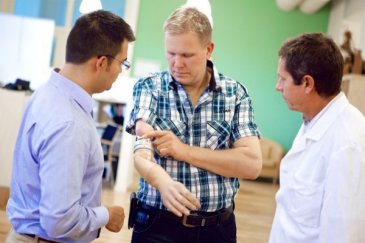Mind-controlled prosthetic limbs that work outside the lab are now a reality, with a Swedish man becoming the first recipient of a fully implanted device in the world.
The prosthetic arm was developed by Swedish scientists, and is the first ever to plug directly into a patient's bones, nerves and muscles, and translate their thoughts into action.
It was implanted into a Swedish amputee in January 2013 in order to test how stable and successful it would be long-term, and now the extremely positive results have been published in the journal Science Translational Medicine.
"Going beyond the lab to allow the patient to face real-world challenges is the main contribution of this work," said Max Ortiz Catalan, the lead author of the publication and a researcher at Chalmers University of Technology in Sweden, in a press release.
But, incredibly, not only has the prostheses restored full dexterous control back to the man's arm, it has also sent feedback the other way and allow him to feel touch sensations through the robotic arm.
The robotic prostheses was linked to the man's body via a process known as osseointegration, which is where an implant such as a tooth or an artificial limb is "plugged" directly into the bone. This technique was developed by researcher Rickard Brånemark and a team at Sahlgrenska University Hospital in Sweden, who also helped create the ground-breaking mind-controlled prosthesis.
In this case, the patient's arm was amputated over a decade ago, and before surgery his prosthesis was controlled via electrodes placed over the skin. This is how current mind-controlled arms operate, as these electrodes can sense signals from nerves in the body and translate them into movement, but the connection is unreliable and they don't restore full function.
In January, the surgeons from Sweden went a step further, and performed an operation to implant neuromuscular interfaces (electrodes that are in direct contact with both the muscle, nerves and the robotic arm) into the remaining part of the patient's arm, in order to directly link his body to a prosthetic robotic arm for the first time in history.
"We have used osseointegration to create a long-term stable fusion between man and machine, where we have integrated them at different levels," said Catalan in the press release.
"The artificial arm is directly attached to the skeleton, thus providing mechanical stability. Then the human's biological control system, that is nerves and muscles, is also interfaced to the machine's control system via neuromuscular electrodes. This creates an intimate union between the body and the machine; between biology and mechatronics."
The press release explains the incredible results experienced by the patient;
He has a physically challenging job as a truck driver in northern Sweden, and since the surgery he has experienced that he can cope with all the situations he faces; everything from clamping his trailer load and operating machinery, to unpacking eggs and tying his children's skates, regardless of the environmental conditions.
This is a huge breakthrough for prosthetics, and the patient is now taking part in a world-first study to see whether the device can restore touch to amputees.
"So far we have shown that the patient has a long-term stable ability to perceive touch in different locations in the missing hand," said Catalan. "Intuitive sensory feedback and control are crucial for interacting with the environment, for example to reliably hold an object despite disturbances or uncertainty. Today, no patient walks around with a prosthesis that provides such information, but we are working towards changing that in the very short term."
The researchers will treat more patients with the new technology later this year.
Watch some of the mind-blowing results below:


Source: EurekAlert
